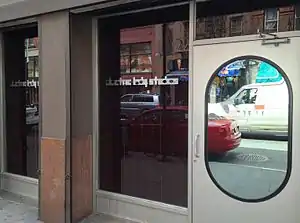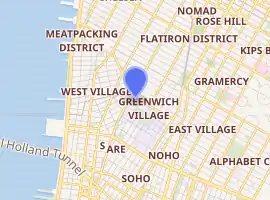Electric Lady Studios
Electric Lady Studios is a recording studio in Greenwich Village, New York City. It was commissioned by rock musician Jimi Hendrix in 1968 and designed by architect John Storyk and audio engineer Eddie Kramer by 1970.[1] Hendrix spent only ten weeks recording in Electric Lady before his death that year, but it quickly became a famed studio used by many top-selling recording artists from the 1970s onwards, including Led Zeppelin, Stevie Wonder, and David Bowie.
 Front entrance in April 2013 | |

| |
| Address | 52 West Eighth Street, Greenwich Village, New York City 10011 |
|---|---|
| Location | New York City |
| Coordinates | 40°43′59″N 73°59′56″W |
| Type | recording studio |
| Opened | August 26, 1970 |
At the turn of the 21st century, Electric Lady served as a homebase to the innovative Soulquarians collective, but soon fell into financial hardship and disarray in the 2000s. With the renovation and new leadership of investor Keith Stoltz and studio manager Lee Foster, the studio returned to form as a popular location for mainstream artists of the 2010s, such as U2, Kanye West, and Lady Gaga.
Pre-history
Electric Lady Studios' current site has a long history. The basement housed The Village Barn nightclub from 1930 to 1967. Abstract expressionist artist Hans Hofmann began lecturing there in 1938, eventually retiring from teaching in 1958 to paint full-time.[2]
1968–1970: Jimi Hendrix and construction
.jpg.webp)
In 1968, Jimi Hendrix and his manager Michael Jeffery bought a newly defunct nightclub, the Generation, in New York's Greenwich Village—a venue that Hendrix had frequented for jam sessions.[3] The Generation had been known for live acts as diverse and legendary as Big Brother & the Holding Company, B.B. King, Chuck Berry, Dave Van Ronk, Sly & the Family Stone, and John Fahey. Instead of renaming the club and continuing with the live venue business model (Hendrix's original vision for the project), advisors Eddie Kramer and Jim Marron convinced Hendrix to convert the space into a professional recording studio, as studio fees for the lengthy Electric Ladyland sessions were astronomical, and Hendrix was constantly in search of a recording environment that suited him. Architect and acoustician John Storyk designed each structural detail, and from there Electric Lady Studios were born. It was the only artist-owned recording studio in existence at the time.

Construction of the studio took nearly double the amount of time and money planned: permits were delayed numerous times, the site flooded due to heavy rains during demolition, and sump pumps had to be installed (then soundproofed) after it was determined that the building sat on the tributary of an underground river, Minetta Creek.[4] A six-figure loan from Warner Brothers was required to save the project.
The studio was made specifically for Hendrix, with round windows and a machine capable of generating ambient lighting in myriad colors. It was designed to have a relaxing feel to encourage Hendrix's creativity, but at the same time provide a professional recording atmosphere. Engineer Kramer upheld this by refusing to allow any drug use during session work. Artist Lance Jost painted the studio in a psychedelic space theme.[5] Jimi Hendrix hired Marron to manage the construction project and run the studio.
Hendrix spent only ten weeks recording in Electric Lady, most of which took place while the final phases of construction were still going on. An opening party was held on August 26, 1970. The following day Hendrix created his last studio recording: a cool and tranquil instrumental known only as "Slow Blues". He then boarded an Air India flight for London to perform at the Isle of Wight Festival, and died less than three weeks later.
1970s–1990s: Height of fame

Into the following three decades, Electric Lady was used to record albums by many popular artists.[6] Stevie Wonder used the studio extensively in the 1970s, when it became what he described as "the self-contained universe" for his work, wanting to depart from the "baby love" sound of his 1960s Motown recordings and "get as weird as possible". Among his recordings there were the 1972 albums Music of My Mind and Talking Book.[1]
As Liesl Schillinger writes in a Wall Street Journal profile on the studio, "from its inception, [Hendrix']s mother ship served as a rock, funk, disco and soul Olympus where gold and platinum hits were forged", including those by Wonder, Led Zeppelin, Lou Reed, the Rolling Stones, and Blondie. In 1971, Gene Simmons and Paul Stanley, then with the New York rock band Wicked Lester, recorded demos at the studio. A few years later, after forming the band Kiss, they used the studio again to record the band's 1975 album Dressed to Kill.[6]
In 1975, John Lennon and David Bowie held an improvisatory session at the studio that produced Bowie's hit single "Fame", recorded for his Young Americans album. That same year, Patti Smith used the studio to record her debut album, Horses. In 1978, Nile Rodgers took his band Chic to Electric Lady and recorded the hit single "Le Freak". "The enchantment held through the '80s and '90s, as AC/DC and the Clash showed up, then Billy Idol, the Cars, Weezer and Santana", according to Schillinger. "The house that Jimi built welcomed them all."[6]
Turn of the century: Soulquarians era

Members of the Soulquarians, an experimental black music collective active from the late 1990s to early 2000s, held many innovative jam sessions while recording their respective albums at Electric Lady, often drawing on the influence of Hendrix and Wonder's recordings there.[1] This period at the turn of the 21st century is known in the studio's history as the Soulquarians era.[6] The collective's activity there began in 1997 when the singer D'Angelo and drummer-producer Questlove (of The Roots) prepared to record the former's Voodoo (2000) album. Their sessions at the studio over the next five years resulted in the Roots' albums Things Fall Apart (1999) and Phrenology (2002), singer Erykah Badu's second album Mama's Gun (2000), rapper Common's Like Water for Chocolate (2000) and Electric Circus (2002), and singer Bilal's debut album 1st Born Second (2001).[1]
Questlove often acted as the director behind the sessions. "I tried to do all in my power that I could to bring people together – to bring Common to Electric Lady, have him record here whenever so that he could record with some of these other artists", Questlove explained in 2002. "You'd just come into [the studio's] A Room, you don't even know who has a session, but you call me: 'Who's down there?' 'Common's in there today.' So you come down, you order some food, sit down and bullshit, watch a movie, and then it's, 'Let's play something.' And I say, 'Who wants this [track]?' And it would be, 'I want it!' 'No, I want it!'"[7]
The Soulquarians' period at the studio ended due in part to the experimental nature of some of their recordings becoming commercial liabilities.[1] Bilal held improvisatory jam sessions at the studio for his second album, Love for Sale, but its experimental direction alienated his label from releasing it, and a subsequent leak led to its indefinite shelving.[8] Common's similarly experimental Electric Circus sold disappointingly, which discouraged his and the Roots' shared label, MCA Records, from letting the artistically-free environment at the studio continue.[1]
Having visited Electric Lady often during the "Soulquarian" period, producer Mark Ronson observed that the studio's "glory-days era had sort of ended". As Schillinger writes, "after the Soulquarians had departed, the place had gone further downhill."[6]
2000s–present: Renovation and continued use

At the start of the 2000s, Electric Lady soon faced a period of financial hardship.[9] By 2010, the studio was taken over by investor Keith Stoltz and studio manager Lee Foster, under whose leadership the studio hosted sessions by Kanye West and Daft Punk.[6] Electric Lady was renovated and expanded, with a new mixing studio added to the second floor and the third turned into a self-contained unit including Studio C, a private lounge, and another mix suite.[10]
The studio has since been used by popular recording artists, such as Keith Richards (for the 2011 expanded reissue of the Stones' Some Girls LP), Daft Punk (for their 2013 album Random Access Memories), U2 (for their 2014 album Songs of Innocence), Adele, and Jay-Z. The mixing engineer Tom Elmhirst held a residency in Studio C, where in 2014 he mixed the Beck album Morning Phase, and has said "this place is a beating heart", in reference to its frequency of work. As Schillinger reports, "one day last winter, seven sessions proceeded simultaneously, including: Interpol in Studio A; Jon Batiste (the bandleader for The Late Show with Stephen Colbert) in Studio B’s live room; and Lana Del Rey, Rod Stewart and producer and singer-guitarist Dan Auerbach of the Black Keys all working on the third floor."[6]
On December 7, 2020, the band Bleachers released a performance video for their song "Chinatown", filmed on the roof of the building, with featured guest Bruce Springsteen. They had recorded the tune in the studio.[11]
See also
- Category:Albums recorded at Electric Lady Studios
References
- Gonzales, Michael (March 19, 2015). "Love, Peace and Soulquarians". soulhead. Retrieved August 20, 2020.
- Berman, Andrew (November 30, 2017). "The long cultural and musical history of Jimi Hendrix's Electric Lady Studios in Greenwich Village". 6sqft. Retrieved August 22, 2020.
- "Electric Lady Studios - Web Exclusives". PBS. Retrieved August 22, 2020.
- Chris Potash, The Jimi Hendrix Companion: Three Decades of Commentary (New York: Schirmer Books, 1996), p. 94.
- "Lance Jost Designs Vintage Paintings". Retrieved April 9, 2007.
- Schillinger, Liesl (August 12, 2015). "Jimi Hendrix's Electric Lady Studios Turns 45". The Wall Street Journal. Archived from the original on August 22, 2020. Retrieved September 25, 2015.
- DeRogatis, Jim. "Just Plain Common Sense". Chicago Sun-Times: February 5, 2006. Archived from the original on 2009-08-24.
- Reyes, Andres (Autumn 2010). "Cool on the Outside". Shook. No. 9. Retrieved August 19, 2020 – via Issuu.
- "The Believer - A River Runs Through It". The Believer. 2015-01-01. Retrieved 2017-08-07.
- Brown, Janice (July 11, 2011). "A Classic Now More Classic: Electric Lady Studios Expands, Adds Neve, API Consoles". SonicScoop. Retrieved July 8, 2017.
- Aniftos, Rania (December 7, 2020). "Bleachers & Bruce Springsteen Perform 'Chinatown' From the Roof of Electric Lady Studios". Billboard. Retrieved December 8, 2020.